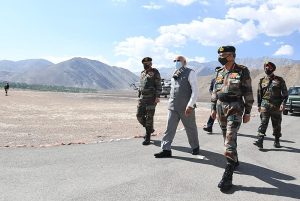Chinese Foreign Minister Wang Yi’s sudden visit to India on March 25 laid bare the strikingly different approaches of the two countries to normalization of bilateral relations. While China would like to put the border dispute on the back-burner to normalize relations with India; New Delhi believes that normalization is not possible so long as the situation at the border is unstable.
The entire China-India border is disputed. The two countries fought a border war in 1962 in which China occupied a chunk of territory in Aksai Chin in Ladakh. In the decades since, the situation at the Line of Actual Control was more or less stable although incursions did happen periodically.
In April-May 2020, Chinese soldiers ingressed at several points into the Indian side of the LAC. The two sides clashed violently at Galwan Valley in June that year, and since then the two sides have been locked in a tense military standoff. Fifteen rounds of military talks and eight diplomatic discussions have taken place so far, and while these have led to troops pulling back from Galwan, Pangong Tso, and Hot Springs, agreement on disengagement from other friction points remains elusive.
Wang’s visit was the first by a top-ranking Chinese official to India since the 2020 standoff began.
In New Delhi he is said to have put forward a three-point proposal. “First, both sides should view the bilateral relations from a long-term vision,” he said. China and India should “put their differences over the border issues at a proper position in the bilateral relations.” Second, the two countries “should view each other’s development with a win-win mentality” and third, they “should take part in the multilateral process with a cooperative posture,” China’s state-run Xinhua News Agency reported.
In other words, China wants India to set aside the current crisis at the border and work with China on other issues. India should not put broader cooperation on hold till the border dispute is resolved. Instead, it should cooperate with China with regard to economic development as in the Belt and Road Initiative, for instance, and forge common positions with Beijing at global forums.
Wang’s three-point proposal is not new. Deng Xiaoping had suggested back in 1988 that India and China should leave the border dispute “for future generations to resolve.” India went along with this proposal, hoping that cooperation in other fields would build bilateral trust, paving the way for a settlement of the border dispute.
However, while cooperation, especially trade, did grow rapidly, the border dispute has festered and only grown in complexity. Enhanced trade, which is heavily tilted in China’s favor, has only increased India’s dependence on China and not helped resolve the border dispute.
Wang’s three-point proposal, which was a reiteration of China’s old approach of prioritizing normalization of relations over settling the border dispute, is therefore unacceptable to India now.
India’s Minister for External Affairs S. Jaishankar reportedly stressed that “restoration of normalcy” in China-India relations “would require restoration of peace and tranquility at the border.” Elaborating on this point at an interaction with the media soon after the talks with Wang, Jaishankar said: “So long as there are very large deployments in the border areas” that violate the 1993 and 1996 India-China agreements, “the border area situation is not normal.”
“The frictions and tensions that arise from China’s deployments [along the LAC in Ladakh] since April 2020,” the Indian foreign minister said, ”cannot be reconciled with a normal relationship between two neighbors.”
Beijing is keen to declare the China-India relationship to be normal. China is hosting an in-person BRICS summit later this year and will be keen to ensure the summit’s success. This would require the leaders of all BRICS member-states to be present at the meeting.
Wang was in New Delhi to ensure that Prime Minister Narendra Modi will attend the BRICS summit. This and not the border dispute was likely to be uppermost on his agenda in the Indian capital — hence, his prioritization of normalization of relations and his call to India to put the border crisis on the back-burner.
In 2017, India and China were locked in a 73-day-long military standoff at Doklam, at the Bhutan-China-India trijunction. Then on August 28 that year, the two sides reached agreement on an “expeditious disengagement of border personnel at the face-off site at Doklam.” It cleared the way for Modi’s participation at the BRICS summit that China hosted in Xiamen in September 3-5.
Is Wang’s three-point proposal aimed at smoothing the way for Modi to participate in the upcoming BRICS summit?
The possibility of Modi participating in the BRICS summit cannot be ruled out. After all, it will be India’s turn to host the G-20 and the Shanghai Cooperation Organization summits next year and India would want President Xi Jinping to be present at these summits.
India would do well to recall what unfolded at Doklam after the August 28, 2017 deal was sealed. As agreed upon, India and China did indeed swiftly disengage their troops from the faceoff site at Doklam. However, within a few weeks of the BRICS summit, media reports pointed out that Chinese soldiers were returning to the site of the crisis and had resumed construction of a road to the Jampheri Ridge (it was China’s construction of this road that had triggered the crisis in June). A few months later satellite images available in the public domain showed the Chinese building several military structures, including a full-fledged military complex, helipads, and trenches, just 81 meters from the point where the two were locked in an eyeball-to-eyeball confrontation in 2017.
Declaring “restoration of normalcy” – what the Chinese want – at the border without achieving disengagement of troops and de-escalation along the LAC will leave India vulnerable again in the Himalayas. New Delhi must not agree to business as usual until the military threat along its Himalayan border has receded.

































